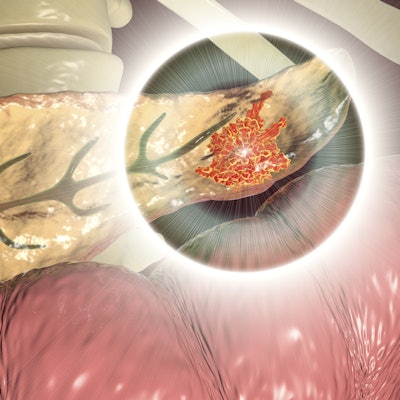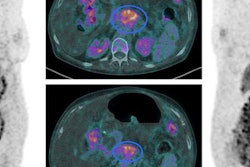
Radiologists may be missing more than a third of pancreatic cancers on CT and MRI -- a finding that raises concern about whether patients are getting timely surgical treatment, according to a team of U.K. researchers.
The group reported its results 10 October at the United European Gastroenterology (UEG) meeting in Vienna.
"There is often only a very short period for curative surgery in pancreatic cancer, meaning it is vital that patients are diagnosed with the disease as early as possible to give them the best chance of survival," lead researcher Dr. Nosheen Umar of the University of Birmingham said in a statement released by the UEG. "The study found that evidence of pancreatic cancer was initially missed in over a third of patients with post imaging pancreatic cancers, which is a huge window of lost opportunity."
Pancreatic cancer is an aggressive disease, with a life expectancy of just over four months at diagnosis, the team noted. It can be hard to identify early because of its nonspecific symptoms, such as jaundice, abdominal and back pain, weight loss, and nausea.
Umar and colleagues conducted a study that included 600 patients diagnosed with pancreatic cancer between 2016 and 2021. The researchers tracked any pancreatic cancers that were found three to 18 months after a patient had undergone initial abdominal imaging with either CT or MRI but had not received a diagnosis of pancreatic cancer at this initial scan -- what they termed "postimaging pancreatic cancer."
Two radiologists reviewed the baseline CT and MRI scans. The researchers then developed a clinical algorithm to categorize any missed cases and assign a reason for why they were missed.
Of the 600 patients, 46 (7.7%) had missed pancreatic cancer diagnoses at the initial scan but then received a diagnosis for the disease three to 18 months later. These postimaging cancers were categorized into the following five groups:
| Categories for missed postimaging pancreatic cancers | ||
| Category of missed cancer | Percentage | |
| No abnormality found on baseline CT or MRI | 40.4% | |
| Missed lesion, imaging adequate and lesion visible on review (perceptual error) | 25.5% | |
| Pancreatic cancer identified and adequate management set, but the cancer was still labeled postimaging | 12.8% | |
| Pancreatic abnormality suggesting cancer identified, but follow-up plan was inadequate (management error) | 10.6% | |
| Missed lesion, inadequate imaging | 10.6% | |
Of the postimaging pancreatic cancers, 36% were considered "potentially avoidable," according to Umar and colleagues. The team also found the following:
- In almost half (48%) of postimaging pancreatic cancer patients, there were signs of cancer that had been missed when scans were reviewed by a hepatobiliary radiologist.
- In 28% of postimaging pancreatic cancer patients, "imaging signs associated with pancreatic cancer, such as dilated bile or pancreatic ducts, were not recognized and investigated further," the team noted.
"We hope this study will raise awareness of the issue of post imaging pancreatic cancer and common reasons why pancreatic cancer can be initially missed," Umar said in the statement. "This will help to standardize future studies of this issue and guide quality improvements efforts, so we can increase the likelihood of an early diagnosis of pancreatic cancer, increase the chances of patient survival and, ultimately, save lives."



















